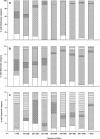THE LEARNING CURVE AND PERFORMANCE OF A NEWLY ESTABLISHED THYROID FINE-NEEDLE ASPIRATION CENTER
- PMID: 36699171
- PMCID: PMC9867803
- DOI: 10.4183/aeb.2022.343
THE LEARNING CURVE AND PERFORMANCE OF A NEWLY ESTABLISHED THYROID FINE-NEEDLE ASPIRATION CENTER
Abstract
Context: Thyroid fine-needle aspiration (FNA) cytology is the best tool for preoperative diagnosis of thyroid carcinoma; however, its learning curve is poorly described. Our aim was to assess the learning curve of a new thyroid FNA center involving unexperienced operator and pathologist.
Methods: We retrieved from our tertiary endocrinology center database all thyroid FNA procedures done by a single operator (endocrinologist with no experience in FNA) between 2018 and 2021. Cytology was assessed by two pathologists with limited or no experience in thyroid cytology. We also got the corresponding sex, age, nodule diameter, EU-TIRADS score, Bethesda category and final pathology report.
Results: There were 1872 FNA in 1618 patients. Proportion of Bethesda 1 nodules decreased significantly (p for trend=0.003) from 17% in the first 100 FNA procedures to 4% in the 401-500 group of procedures, and remained constant between 9% and 4% (p for trend=NS) for the rest of the study. Proportion of Bethesda 2 rose steady from 26% in the first 100 nodules to 80.1% in the last 241 nodules (p for trend<0.001). Indeterminate lesions (Bethesda 3 and 4) decreased significantly (p for trend=0.001) from 16% and 35% in the first 100 nodules to 2.5% and 5.8% in the last 241 lesions. Proportions of Bethesda 5+6 categories varied non-significantly over time. There were no time trends in the malignancy rate of surgically removed nodules.
Conclusions: At least 300 procedures are needed to reach the standard performance. A steadily state for the whole center is obtained after about 500 procedures.
Keywords: Bethesda category; learning curve; thyroid fine needle aspiration.
©2022 Acta Endocrinologica (Buc).
Conflict of interest statement
All authors declare that there is no conflict of interest that could be perceived as prejudicing the impartiality of the research reported.
Figures



References
-
- Pinchera A. Thyroid incidentalomas. Horm Res. 2007;68(5):199–201. - PubMed
-
- Wilhelm S. Evaluation of thyroid incidentaloma. Surg Clin North Am. 2014;94:485–497. - PubMed
-
- Gharib H, Papini E, Garber JR, Duick DS, Harrell RM, Hegedüs L, Paschke R, Valcavi R, Vitti P, Balafouta ST, Baloch Z, Crescenzi A, Dralle H, Frasoldati A, Gärtner R, Guglielmi R, Mechanick JI, Reiners C, Szabolcs I, Zeiger MA, Zini M. American association of Clinical Endocrinologists, American college of endocrinology, and Associazione Medici Endocrinologi medical guidelines for clinical practice for the diagnosis and management of thyroid nodules-2016 update. Endocr Pract. 2016;22(5):622–639. - PubMed
-
- Haugen BR, Alexander EK, Bible KC, Doherty GM, Mandel SJ, Nikiforov YE, Pacini F, Randolph GW, Sawka AM, Schlumberger M, Schuff KG, Sherman SI, Sosa JA, Steward DL, Tuttle RM, Wartofsky L. 2015 American Thyroid Association Management Guidelines for Adult Patients with Thyroid Nodules and Differentiated Thyroid Cancer: The American Thyroid Association Guidelines Task Force on Thyroid Nodules and Differentiated Thyroid Cancer. Thyroid. 2016;26:1–133. - PMC - PubMed
-
- Cibas ES, Ali SZ. The Bethesda System for Reporting Thyroid Cytopathology. Am J Clin Pathol. 2009;132:658–665. - PubMed
LinkOut - more resources
Full Text Sources
Miscellaneous
